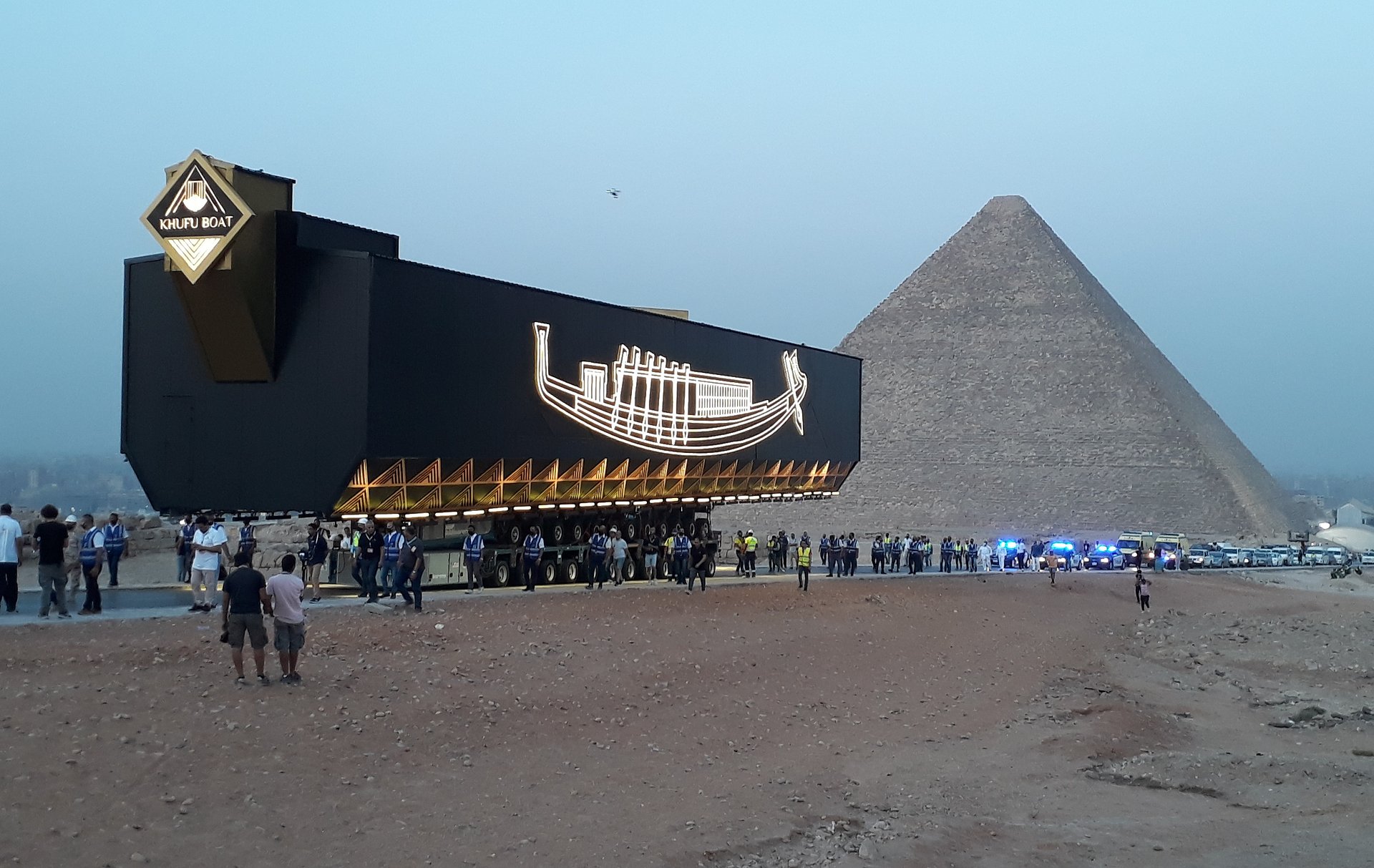This project, which required an investment of more than $1.2 billion, took more than two decades from the start of construction to its inauguration on November 1st.
In addition to a collection of more than 100,000 pieces distributed across 12 galleries and the complete collection of objects belonging to Tutankhamun, the museum will house King Khufu's barge, which Sarens was responsible for transporting in 2021. This involved a major logistical operation from the Great Pyramid to the museum, covering more than 10 km.
The design of the Grand Egyptian Museum required a massive use of materials: 250,000 m³ of concrete, 10,000 tons of structural steel, and more than 210,000 m² of stone for façades and finishes, with precise controls over loads, vibrations, settlement, and logistics.
The opening of the new Grand Egyptian Museum (GEM) in Giza on November 1st will give a major boost to the economy and tourism in the area, with estimates suggesting that visitor numbers will double to 30 million by 2028. This is a significant increase, considering that 2024 has so far seen a record number of visitors, with 15.7 million. This project thus becomes the world's largest museum dedicated to a single civilization, with a total area of more than 50 hectares spread over 12 galleries.
The new museum has involved an estimated investment of more than $1.2 billion, of which approximately $800 million corresponds to loans from Japan. Its construction has not been easy, taking more than two decades to complete, culminating in its opening to the public on November 4th,, three days after the official inauguration. This project came at a time of clear expansion in the country's construction sector, which is expected to grow by around 6.5% this year, driven by new investments in infrastructure, energy, and commercial projects in particular. For the 2026–2029 period, an additional average annual growth rate of 7.4% to 7.6% is projected, supported by foreign direct investment (FDI) and the development of industrial and commercial sectors.
This logistical operation, carried out in August 2021, was a real challenge for the Sarens engineering team, given the need to transport a historic wooden structure for approximately 10 km. To this end, and in coordination with BOJV, it was decided to build a ramp that could be used throughout the journey and would allow the 12-axle-line SPMT K24 and 12-axle-line SPMT K25 to move with agility. As a preliminary step, BOJV built a steel cage to properly protect the barge, which was 43 meters long and weighed 20 tons. Sarens, for its part, prepared a steel bridge 52 meters long and 5.6 meters high so that the SPMTs could be positioned directly under the relic.
The 12-axle-lines SPMT K24 carefully lifted the barge from its support and transported it to the outskirts of the museum, passing through a gap with a margin of only 20 cm on each side, before loading it onto the 12-axle-lines SPMT K25. Once transported to the Grand Egyptian Museum, an 800T CC4800 SSL/LSL 90m Superlift crane with a capacity of 300T unloaded the barge to install it in its current location.
As Pieter Augustyns, Deputy Managing Director Sarens Project Europe & Latam states, “the construction of the Grand Egyptian Museum clearly demonstrates the growing demand in the region for heavy lifting solutions, specialised transport, and the assembly of highly complex structures, areas in which Sarens is a world leader. The manoeuvres required to transport monumental archaeological pieces, install high-tonnage structural elements, and operate high-capacity cranes in sensitive environments highlight the need for companies with proven experience in logistical engineering and critical operations. Furthermore, the rise of cultural, tourism, and infrastructure projects in Egypt and the Middle East presents a strategic opportunity for Sarens to participate by bringing its capabilities in precise lifting operations and modular transport, essential for ensuring the safety, efficiency, and success of projects of this scale”.
In addition to housing an exhibition of more than 100,000 pieces, including the complete collection of Pharaoh Tutankhamun for the first time, the GEM will display King Khufu's funeral boat, also known as the Solar Boat of Cheops, as one of its main tourist attractions. This historical artifact, which is over 4,600 years old and considered the oldest wooden relic in human history, was transported from its original location in the museum next to the Great Pyramid to the GEM with the direct involvement of Sarens.
Sarens has a long track record in projects that have required enormous care in transport operations. This is the case of the Toulouse monument to the fallen combatants of Haute-Garonne project, where Sarens was in charge of moving the 15-meter-high, 1,370-ton memorial. The building was moved 30 meters and rotated 90 degrees to be temporarily stored until its reinstallation in another part of the city of Haut-Garonne. Also noteworthy is the assembly of the Mobile Launcher 2 (ML2), the structure that will be used to launch the Space Launch System rocket of NASA's Artemis Program. These projects demonstrate Sarens' extensive experience in the industry and its ability to tackle logistical challenges that require critical precision and care.
About Sarens
Sarens is the global leader and reference in crane rental, heavy lift and engineered transportation services. With state-of-the-art equipment, value engineering, one of the world's largest inventories of cranes, transporters and special rigging equipment, Sarens offers creative and intelligent solutions to today's heavy lifting and engineering transport challenges.
With more than 100 entities in 65 countries operating without borders, Sarens is an ideal partner for small to large-scale projects. Sarens currently employs 5,000 highly qualified professionals who are ready to serve the needs of any client worldwide and in all market sectors. https://www.sarens.com/

